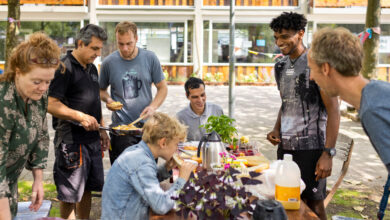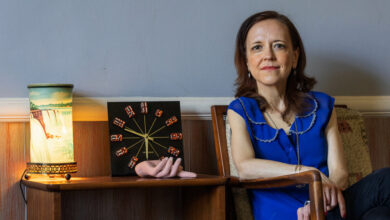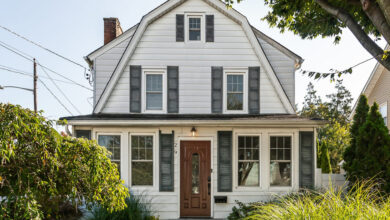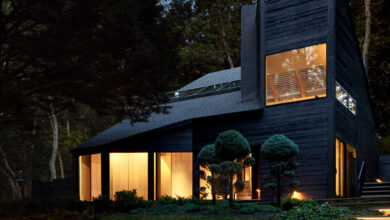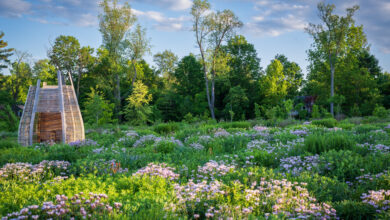Los Angeles Never Felt Like Home. Now They Live in a Redwood Forest.
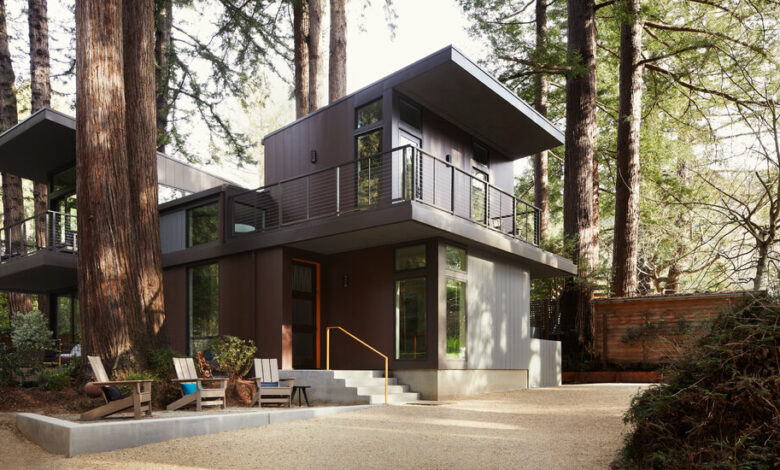
[ad_1]
Robin Engelman lived in the Los Angeles area for three decades, waiting for a sense of belonging that never came. “I never quite felt at home,” said Dr. Engelman, 56, a psychologist. “I was raised in rural Pennsylvania and wanted a smaller town that was more green and more friendly, with seasons and trees. I wanted to find home.”
Her husband, Tom Engelman, a film producer who has worked on movies including “The Last Samurai” and “Pitch Black,” was born and raised in L.A., but was willing to consider a change. “It was largely driven by Robin, given my lifestyle,” said Mr. Engelman, 62, though he shared her dream of living in a beautiful spot where the surroundings would provide “a daily shock-and-awe experience.”
For years, they daydreamed about real estate and looked at a few houses. Then, in early 2019, on a drive north to visit family in Marin County, they stumbled upon a place in Mill Valley that captivated them. “We hit this grove where we were looking through the trees with the God light,” Mr. Engelman said, describing the way the beams of sunlight sliced through the majestic redwoods.
They saw something else, too: a ramshackle 800-square-foot cabin on a 0.1-acre lot that was for sale. “Robin just said, ‘I’m home,’” Mr. Engelman recalled. “It was over.”
They had little time to inspect the property and weren’t able to get inside before Dr. Engelman had to return to Los Angeles. Nevertheless, they took a big chance and bought it for $836,000.
“It was a leap,” Mr. Engelman said — especially as they both had busy careers in the city and needed to consider their son, Reese, now 13. (They also have two older children who had already moved out.) “I wouldn’t say we are the kind of people who always make leaps like that, but in this particular case, we did.”
They began using the cabin as a second home while they got a feel for the property and planned their next steps. A few months later, they sold their home in Santa Monica and moved into a nearby rental apartment.
“We did find out that the house was old without being historic — and falling down,” Mr. Engelman said, meaning it was ripe to be demolished and replaced. “It allowed me to pursue a dream I’ve had my whole life: to build something with our own vision, from scratch.”
But while they had enthusiasm and experience remodeling homes, neither was an architect. To help realize their vision, they hired Richardson Pribuss Architects, a local firm that had built many modern homes in the area.
When they sat down with Heidi Richardson, a founding partner of the firm, she explained that the footprint of the house would be largely dictated by what was already there. “The site itself determined the shape of things, because we didn’t want to cut down one redwood tree — those are sacred,” Ms. Richardson said. “By the time we obeyed the setbacks and dodged the redwood trees, this was pretty much the shape that was left.”
The resulting two-story, three-bedroom, 1,600-square-foot house is threaded between tree trunks, with windows and decks to take in views near and far. Some of the windows deliberately frame views straight into tree trunks, Mr. Engelman said, “to feel like we’re right there, living with these creatures.”
The longer views out into the forest make the lot feel larger than it is, Ms. Richardson said, describing the concept as “borrowed landscape.”
A circular skylight over the living room — a request from young Reese, after seeing photos of modern homes with circular windows in nearby Sea Ranch — allows you to “look up and see a circle of trees,” Mr. Engelman said. Also, “the light from both the sun and moon travels around the living room floor, day and night.”
To leave tree roots undisturbed, the architects set the house on a slab foundation built up higher than the forest floor. For fire safety, they avoided using wood on the exterior, cladding it instead in cement board and painted metal siding. The decking is made from a composite.
Inside, they used plenty of wood for visual and tactile warmth, including white oak flooring and cabinetry, and a fireplace surround made from charred shou-sugi-ban cedar. In the bathrooms, Porcelanosa tile has the look and feel of hardwood strips.
After the old cottage was demolished in June 2020, it took about a year and a half to build the new house, which was completed in January 2022 at a cost of about $600 a square foot. Although their builder, Hayes & Associates, led the charge, Mr. Engelman threw himself into the project, visiting the site almost every day and laboring alongside his contractors.
“I came out of it with neuropathy in both hands that was just crippling, from using sledgehammers and jackhammers and such,” he said. “I had tennis elbow in both arms. I had shoulder injuries. I was an absolute mess for about six months after construction.”
“But I must say,” Dr. Engelman interjected, “he said it was the happiest time of his life.”
Now that Mr. Engelman has recovered, the couple have had time to fully appreciate what they’ve accomplished. Every morning, Dr. Engelman said, they look out the windows and can hardly believe their eyes: “It’s ridiculously magical.”
For weekly email updates on residential real estate news, sign up here.
[ad_2]
Source link


